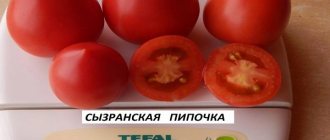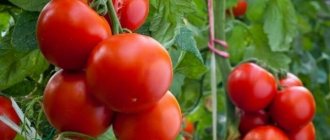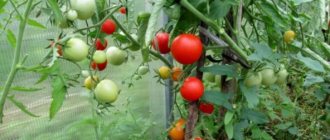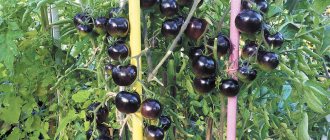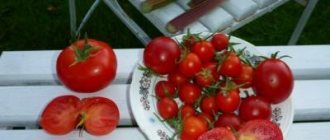Tomato Solaris - description and characteristics of the variety
The Solaris variety is one of the most popular and highest quality tomato species of Moldavian selection. It is included in the State Register of the Russian Federation and is intended for cultivation both in film structures and in open ground. This variety of nightshade is characterized by low maintenance and good adaptive qualities. The crop is grown in many Russian regions, including East Siberian and North Caucasus.
To successfully grow and obtain a large amount of high-quality harvest, you need to correctly carry out agrotechnical measures. The manufacturer indicated the characteristics of this tomato variety, as well as care tips, on the packaging with the seed.
Description of the variety
The plant is determinate, its height does not exceed 80-90 centimeters, with medium foliage. The inflorescences are simple, the formation of the first of them occurs over the sixth or seventh leaf, the next inflorescences are formed after one or two leaves. The peduncle is articulated.
The bushes are trimmed independently after four to six brushes. The Solaris tomato variety is characterized by good resistance to many diseases characteristic of nightshades. Including late blight, fusarium, alternaria, anthracnose, and tobacco mosaic virus.
Medium early variety. The ripening period - from the appearance of the first shoots to the ripening of the fruits - is about 110 days. The yield is quite high. In areas with a cool summer season, greenhouse cultivation is recommended. The variety tolerates elevated air and soil temperatures well, and is also undemanding in general care.
Description of the harvest
Gardeners who grew Solaris tomatoes on their plots describe the resulting harvest as follows:
- The fruits are large, each weighing up to 170 grams.
- The harvest is stored for a long time (up to 4 months).
- Tomatoes of this variety have a flat-round shape.
- The skin is smooth.
- The fruit contains about 3.3% sugar and 4.9% dry matter.
- The taste can be described as sweetish, with slight sourness.
- Each tomato contains three to four seed chambers.
- Fresh vegetable salads, tomato juices are prepared from the fruits, and they are also canned.
The plant produces 5-7 fruits on each cluster. From one square meter you can harvest about 6 kilograms of crop.
How to grow
Seedlings for seedlings are planted in the second ten days of March.
The container should be filled to the middle with soil. Before planting, it is recommended to immerse the seeds in a growth stimulator for half an hour, then dry them naturally in the sun. The seed is lowered into the ground with a depth of 1.5 centimeters, and the top is sprinkled with peat or soil. After this, the seedlings are watered with settled warm water. The container with the planted seeds should be covered with film and placed in a warm place until the first shoots appear. Then the container with seedlings must be moved to another place that is well lit. Experienced gardeners in most cases opt for window sills or heated loggias.
It is necessary that the room where the seedlings are located is warm. It is necessary to regularly ventilate the seedlings, however, avoiding drafts.
Seedlings are planted in beds and greenhouses in May. When grown in open ground, bushes should be covered with film at night. This may not be done after the last spring frosts have passed.
10 days after planting the seedlings in a permanent place, they need to be fertilized using complex fertilizers. Then you should care for the plant as usual.
This tomato variety has excellent characteristics. When grown, you can harvest a large amount of high-quality harvest. The fruits have a pleasant taste. The plant is undemanding in terms of care. Experienced gardeners who planted Solaris on their plots speak extremely positively about this variety.
Video: Solaris tomatoes
Features of care
The procedure for caring for the Sunrise hybrid is, in general, standard. The beds should be kept clean by carrying out timely weeding and loosening after watering. But there are some nuances, without which the taste of the fruit and its yield may not reach its standard.
- Watering. The planted seedlings are watered as usual, allowing the plant to quickly adapt and begin to form a crop. But then, when the fruits are in the ripening stage, the frequency of watering is reduced to 1 time in 10 days in hot weather. If the weather is cloudy, then water even less often. This watering regime will allow more sugars to accumulate in the Sunrise tomato fruits, so that the sourness present in the taste does not become dominant.
- Shaping and garter. During the growth period of the Sunrise tomato, pinching is required. Despite the short stature of the bush, during the ripening of the fruit clusters they should be tied up, since heavy fruits can cause a break in the fragile branch.
- Fertilizers. Potassium nitrate and phosphorus-containing compounds are most often used as the main fertilizer. Most of them are introduced during the period of fruit formation.
To prevent the soil under the Sunrise tomato bush from becoming waterlogged, try to use a drip irrigation system
Solaris – variety of tomato plant
Variety characteristics:
Properties of the Solaris variety:
Recommended region on the map:
Information on the admission of Tomato Solaris from the Register of the State Variety Commission of the Russian Federation
Application for admission No. 32346, registered 1999-02-25. The Tomato Solaris variety was included in the register of approved varieties in 2000. Approved for use in the regions: North Caucasus, East Siberian.
The originator of the Tomato Solaris variety is:
Other varieties of tomato plant
Search for variety by name
Variety selection
Question to the portal experts
If you haven't found the answer to a question, don't hesitate to ask an expert.
Have you already planted Tomato Solaris?
Tell us if you liked this variety? Will you plant it again?
Register or Login so you don't have to enter your Name and Email every time
Thanks for the comment! It will be published after checking by a moderator!
No comments yet, be the first!
A portal for those who love their dacha
Your question has been sent for moderation. Don't worry, we quickly check your questions and your question will be answered within 1 day.
We have noticed that you are already registered on our website. We recommend that you log in to view the question you created. If you don't remember your password, you can recover it.
You were not registered until today, so we have registered you. Your password has been sent to your specified mailbox.
Help our site develop!
Please read this message, it will not take up much of your time!
We so need your comments and questions to understand in which direction we should develop.
Don't forget to leave a comment if you found what you were looking for. And if you haven’t found it, use the “Ask an Expert” form in the site header. We will answer this question, and other visitors will be able to find the information that you could not find.
Sincerely, team of the portal Dacha-Dacha.ru
Your question has been sent for moderation. Don't worry, we quickly check your questions and your question will be answered within 1 day.
We have noticed that you are already registered on our website. We recommend that you log in to view the question you created. If you don't remember your password, you can recover it.
You were not registered until today, so we have registered you. Your password has been sent to your specified mailbox.
Landing
The variety prefers sunny areas, well protected from winds and drafts. In the northern regions, as well as in areas with little snow but frosty winters, the trench method is used for planting. This technique perfectly protects the roots from freezing. In southern climates, grapes are grown on an open surface, sometimes raising the trunk circle in the form of a mound.
To plant seedlings, pits measuring 80x80x100 centimeters with a drainage layer are prepared in advance. The unpretentiousness of the plant allows it to be planted on any soil, with the exception of swampy and saline soils. Like all grape varieties, Solaris does not tolerate close proximity to groundwater and does not like waterlogging.
Soil enriched with mineral and organic fertilizers is poured into a mound into the hole and a seedling is placed on top. Its roots are first dipped into a mixture of mullein and clay, and then carefully spread over the entire surface of the soil. Cover the top with the remaining soil, being careful not to deepen the root collar. After planting, the tree trunk circle is shed generously with warm water, after a couple of days it is loosened and mulched.
For tall bushes, the placement scheme includes a distance between seedlings of 2 m, between rows - 3 m.
Tomato Solaris - description and characteristics of the variety
In order to successfully grow and obtain a large quantity of high-quality crops, it is necessary to carry out agrotechnical measures regularly. The manufacturer indicated the characteristics of this variety of tomatoes, as well as advice on care, on the packaging with the seed.
Description of the variety
The testis is determinate, its height does not exceed 80-90 centimeters, medium leafy. The inflorescences are simple, the formation of the first of them occurs over the sixth or seventh leaf, the next inflorescences are formed through one or two leaves. The peduncle is articulated.
Termination of bushes is carried out independently after four to six brushes. The Solaris tomato variety is characterized by good resistance to many diseases typical of nightshade plants. Including late blight, fusarium, alternaria, anthracnose, and tobacco mosaic virus.
Mid-early genus. The ripening period - from the appearance of the first shoots to the ripening of the fruits - is approximately 110 days. The yield is quite high. In areas with a cool summer season, cultivation in greenhouse conditions is recommended. The variety tolerates elevated air and soil temperatures well, and in turn is undemanding in general care.
Description of the harvest
In many characteristics, Solaris has surpassed until now one popular variety of Moldavian selection - Perseus. Unlike the latter, the colorful red fruits of the Solaris variety do not have a green spot near the stalk. Moreover, he significantly surpasses Perseus in terms of harvest quantity. And both varieties are characterized by good transportability and a long shelf life.
Gardeners who grew Solaris tomatoes on their plots describe the resulting harvest as follows:
- The fruits are large, each weighing up to 170 grams.
- The harvest is stored for a long time (up to 4 months).
- Tomatoes of this variety have a flat-round shape.
- The skin is smooth.
- The fruit contains about 3.3% sugar and 4.9% dry matter.
- Passion can be described as sweetish, with a slight sourness.
- Each tomato contains three to four seed chambers.
- Fresh vegetable salads, tomato juices are prepared from the fruits, and they can also be preserved.
The plant produces 5-7 fruits on each cluster. From one square meter all that remains is to collect about 6 kilograms of crop.
How to grow
The seed is lowered into the ground with a depression of 1.5 centimeters, and sprinkled with peat or earth from a bird's eye view. After this, the seedlings are watered with settled warm water. The container with the planted seeds should be covered with film and placed in a warm area until the first shoots appear. Then the container with seedlings must be dragged to another place that is well lit. Experienced gardeners in most cases opt for window sills or heated loggias.
It is necessary that the room where the seedlings are located be warm. It is necessary to regularly ventilate the seedlings, while still avoiding drafts.
After two leaves appear on the seedling, it is a good idea to pick it. It is advisable to use peat pots for these purposes, so as not to remove the bushes from the container when planting them on a permanent outskirts, so their adaptation to the new soil will be faster.
Seedlings are planted in beds and greenhouses in May. Bushes grown in open ground should be covered with film at night. You don’t have to do this after the last spring cold ends.
Features of cultivation
Since the Sunrise hybrid is grown with equal success in open ground and in protected ground, the following planting methods are practiced: sowing seeds and planting seedlings.
Seed preparation is carried out in the usual way. Sowing seeds for seedlings is carried out in March. Seeds germinate at a temperature of 25°C. In the phase of 2 true leaves, the seedlings dive. Hardened seedlings are planted in protected or open ground at the age of 35–45 days.
The seedling method is most suitable for cool regions. But in areas where spring comes early and the soil quickly warms up to the 12–14°C required for planting, this method also enjoys well-deserved respect. Thanks to grown seedlings, gardeners have the opportunity to get a harvest earlier than by sowing a variety with seeds.
The seedling method of growing Sunrise tomatoes is suitable for any region
Since the Sunrise tomato has fairly compact bushes, the distance between seedlings in the garden bed can be left up to 40 cm. Row spacing also does not differ in width - 50 cm is quite enough.
The seed method, although not as successful as the seedling method, is also suitable for growing this variety. It is used only in the southern regions. The sowing time for seed material falls at the end of April - beginning of May. To create comfortable conditions for seeds to germinate, a shelter is installed above the bed.
Tomato Solaris characteristics and description of the variety
One of the most popular and high-quality varieties of Moldovan selection is the Solaris tomato. It is included in the State Russian Register and is suitable for cultivation both in open ground and in greenhouses and hotbeds. This type of nightshade is distinguished by its unpretentiousness and good adaptive qualities. The Solaris variety is suitable for cultivation in the East Siberian and North Caucasus regions of the country.
In order to get a strong plant and a rich harvest, you need to competently and competently approach the cultivation and care of tomatoes. The manufacturer placed a description of the Solaris variety and recommendations for growing on the package of seeds.
General characteristics of the variety
Solaris tomatoes are mid-season varieties. This species is determinate; an adult bush does not reach more than 80–90 cm in height.
The plant has a compact and neat appearance; Its foliage is average. The leaf is ordinary in shape and has a deep green color. The tomato inflorescence is simple; the first ovary is formed above the 6-7 leaf, then after 1-2 leaves.
The Solaris variety has an articulated stalk. After the formation of 4-6 inflorescences, the bushes stop growing on their own. The plant has good immunity and is resistant to many diseases, such as late blight, fusarium, alternaria and TMV. The Solaris tomato variety is considered unpretentious. It tolerates minor changes in air and soil temperatures well. The culture does not cause much trouble in care.
The fruits of this type of nightshade have a flat-round shape with slight ribbing. The tomato is covered with a dense, smooth and shiny skin. It protects the fruit from scorching sun rays and from cracking. Thanks to its properties, tomatoes are stored for a very long time, on average about 4 months. They tolerate long-term transportation well.
The average weight of 1 tomato is about 170 g. The fruits of Solaris tomatoes are quite large, so the bush needs garter and additional support, although many gardeners do not consider this a prerequisite. On average, about 5-6 pieces are tied on 1 tassel. The fruits have 3-4 chambers, are red in color, without spots around the stalk.
The taste of tomatoes is excellent. They have a sweetish-sour taste with spicy notes. The tomato is suitable for universal use. Juice, paste, lecho and vegetable salads are prepared from it.
The Solaris variety is suitable for cultivation for production purposes and is suitable for mechanized harvesting.
photo by Valentina Redko
Description and characteristics of the Solaris tomato variety, reviews, photos
An early, high-yielding, low-growing tomato variety for open ground. The period from germination to the beginning of ripening is about 100 days.
The bush is of a determinate type, up to 70 cm high. It requires tying the plant to a support and partial pinching (preferably up to the first flower cluster). The leaf of this tomato is ordinary, medium in size. The inflorescence is simple. The first inflorescence is formed above 6-7 leaves, subsequent ones every 1-2 leaves.
In 2000, the Solaris tomato variety was included in the State Register for the North Caucasus region for cultivation in open ground.
Basic qualities of fruits
The fruits are round, dense, red in color at maturity, weighing 80-150 grams, juicy, good (for early varieties) taste. These tomatoes are suitable for early fresh salads, processing, and home cooking.
Advantages of tomato : high yield, excellent commercial quality of fruit, resistance to major tomato diseases.
There were many reviews on the garden forum that this variety is often grown for market sale of early tomatoes.
Features of cultivation, planting and care
Sowing the seeds of this variety of tomatoes for seedlings is carried out 50-55 days before the intended planting in the ground. Seedlings dive at the stage of two true leaves. When planting seedlings in a permanent place per 1 sq. It is recommended to place up to 5 plants per meter of plot.
Further care for tomatoes consists of timely watering, fertilizing with complex mineral fertilizer, pinching and preventive measures to protect against diseases and pests.
If you grew Solaris tomatoes, please write whether you liked them or not. What was the yield and taste of the fruits like under your climatic conditions? How do you rate the disease resistance of this variety? Briefly describe the advantages and disadvantages of this tomato in your opinion. If possible, attach a photo of your tomatoes to your comment. Thank you!
Your reviews of the Solaris tomato and additions to the description will help many gardeners evaluate this variety more objectively and decide whether it is worth planting or not.
Not a variety, but a gift to the gardener! What is it about? Of course, about the Solaris tomato variety. More details about unpretentious and productive, and most importantly tasty tomatoes can be found in this article.
Tomato variety "Solaris":
Origin of the Solaris tomato variety
The Solaris variety was developed by breeders from Transnistria. This tomato was entered into the Russian plant register in 2000. And gardeners popularly call it the improved “Perseus” because of the similarity of the varieties.
Description of the variety
The tomato is a mid-early variety. The fruits ripen 100-105 days after the first shoots appear. In general, Solaris has the following characteristics:
- The bush is powerful, but not tall. Reaches approximately 80 cm in height;
- The leaves are not large, dark green in color. There are not too many leaves on the bush;
- The inflorescence is simple and it appears above the 5th-6th leaf;
- The fruits are bright, red, not ribbed, but have a beautiful round shape. The skin is smooth. Weight of tomatoes is 120-170 grams. They have 4 cameras. The taste is sweet with a slight sourness. The fruits are also quite aromatic.
Tomatoes: advantages and disadvantages
Let's look at why this plant is better than others:
- The fruits have excellent taste;
- The skin of tomatoes is dense and due to this the fruits are very transportable and can even withstand mechanized harvesting;
- High yield of bushes;
- Have good immunity;
- Unpretentiousness;
- Ability for long-term storage;
- Tolerates high temperatures well.
Application of fruits
These tomatoes are universal in their use. They can be eaten raw, added to salads, canned for the winter, and made into delicious tomato juices.
Growing tomatoes
How to prepare seeds?
There is no need to specially prepare purchased seeds, but you can sort out unusable material using a salt solution.
Sowing seed material
In the second half of March, it is recommended to sow tomato seeds.
Different varieties of tomatoes:
To do this, take special soil purchased in the store, or prepare it yourself. Then the material is sown to a depth of 1.5 cm and crushed with earth. Before the first shoots appear, you can cover the pot with the seeds with a film that has holes in it. Place the pot in a warm and well-lit place.
Planting grapes
These grapes are planted in open ground according to the rules common to most varieties. There are a number of important factors to consider:
- This variety is very demanding of sunlight, so it should be placed on the site so that the shadow of buildings does not fall on the plant for as long as possible.
- Solaris must be protected with screens and fences from sharp northern winds.
- In the northern regions, as well as in areas with little snow but frosty winters, the plant is planted in a hole. This helps protect the roots from freezing. In the southern regions, on the contrary, it is better to plant grapes on a mound so that the root system is well warmed by the sun. In both cases, the soil must be pre-prepared: lay a drainage layer of at least 15 cm at the bottom of the planting hole, and a layer of nutritious soil on top. It can be anything, but not too wet. The plant develops poorly only in salt marshes and swampy areas.
To ensure normal, full development of the plant, it is worthwhile to carry out planting work correctly.
Selection of seedlings
This plant belongs to the category of hybrid varieties. Therefore, you can only purchase a high-quality seedling in a nursery, from a collector or in a special store. Only in this case can you be sure of the originality of the variety and the high quality of the seedling.
When choosing a plant, you should consider the following features:
- Condition of the roots. They must not include dry or damaged fragments. There should be no rotten areas on the surface of the root system. Otherwise, the plant will take root poorly and will not produce the desired harvest. To assess the condition of the roots, it is recommended to carefully cut off a small fragment with a sharp knife. If the cut area is white and moist, this indicates that the shoot can be planted in the ground. A dark section indicates tissue death.
- Trunk and leaves. A plant with a woody trunk and many leaves rapidly loses moisture and nutrients. Such crops do not take root well and produce poor harvests.
- Vine. To purchase a high-quality seedling, you need to cut 3-5 millimeters from the top of the plant and examine the cut area. A quality vine in this location should have a lush green tint. If the cut is dull, this indicates a low quality plant.
- Age. For planting in open ground, experts recommend using grapes no older than 2 years.
The plant is distinguished by its demands on light. Therefore, it is recommended to choose an area where the shadow of a fence or building does not fall for a long time. At the same time, the bush needs protection from the cold north wind.
In regions with a harsh climate or areas with little snow in cold winters, the bush is planted in a hole. This will help avoid freezing of the root system. In warm areas, it is recommended to plant grapes on a mound. This will help warm the roots of the plant with the warm rays of the sun.
It is worth laying drainage at the bottom of the planting hole. After this, it is recommended to place a layer of nutrient soil. When carrying out planting work, it is worth observing an individual interval. It should be at least 1.5-2 meters.
The planting depth should be 35-45 centimeters. To speed up the development of the crop, it is worth adding an Initiator tablet under the seedling.
Planting work is recommended to be carried out in spring or autumn. In the first case, it is recommended to plant grapes in April or May. When planting in autumn, this is done in October or November.
To achieve good results when planting a plant, it is recommended to do the following:
- dig a hole measuring 70x70 centimeters;
- make a high-quality drainage layer;
- add organic fertilizers - humus or manure;
- sprinkle them with soil and water them generously – it is recommended to use at least 5 buckets of water;
- after absorbing moisture, make a small hill and plant the crop;
- sprinkle the plant with soil - the first buds should remain on the surface;
- Make a depression around the hole - pour water into it;
- When moisture is absorbed, cover the ditch with soil.


